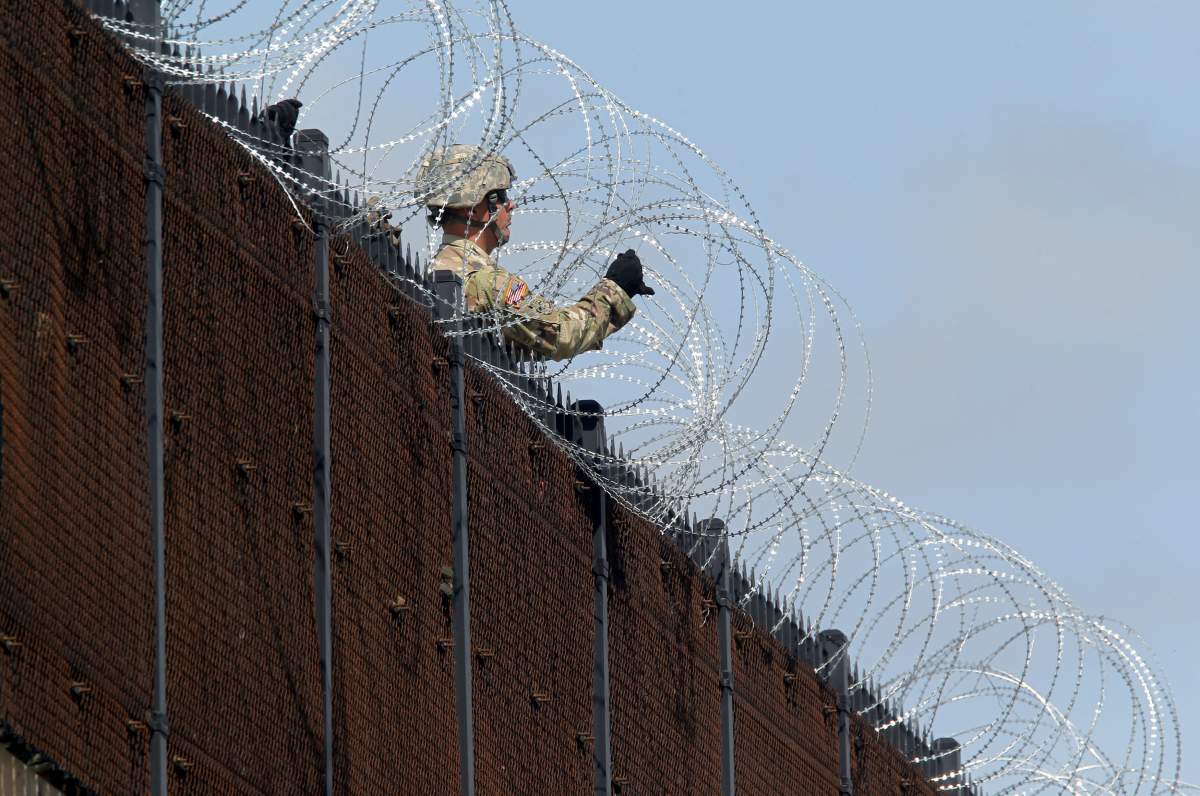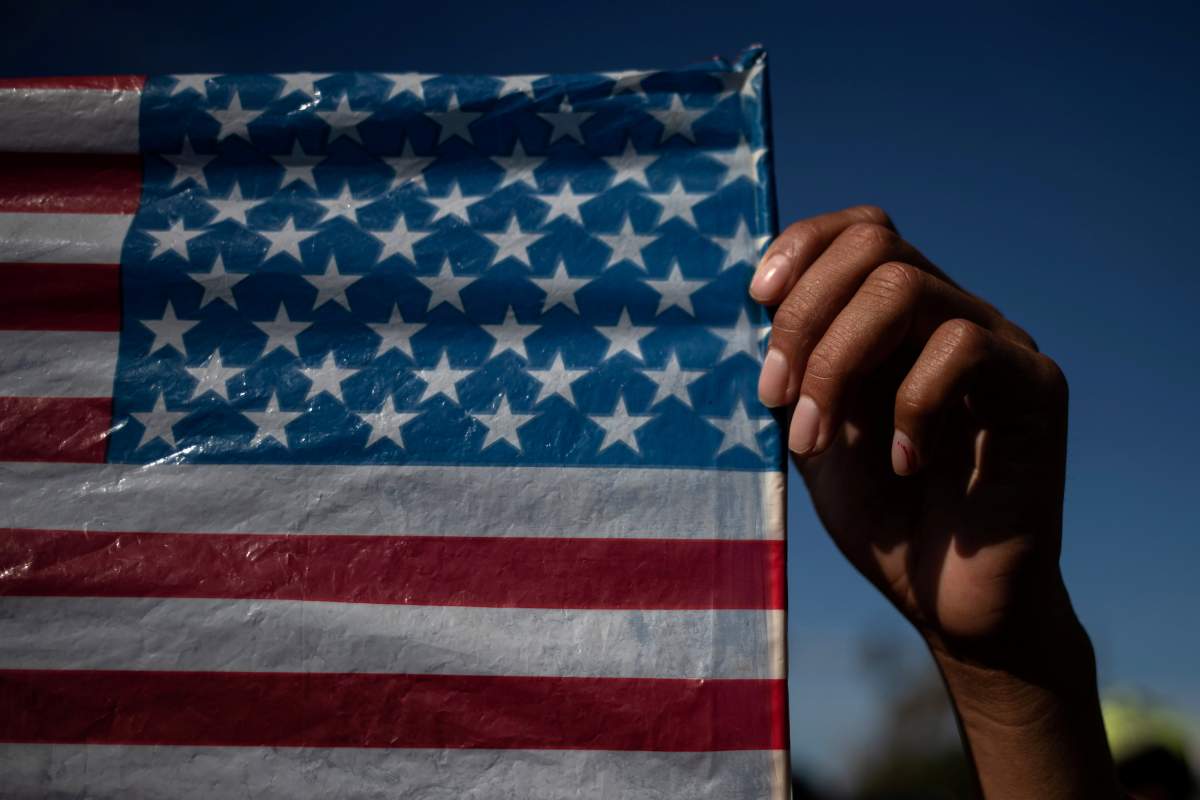U.S. President Donald Trump takes a hard line on people he has said are entering his country illegally.

“Rapists,” he called Mexicans coming into America when he announced his run for the presidency in 2015.
“Unknown Middle Easterners,” he erroneously said were among a migrant caravan moving from Central America.
Coverage of migrants at the U.S. border on Globalnews.ca:
Trump used this kind of rhetoric to fire up his voting base ahead of the recent U.S. midterm elections — talk that gave the impression of a crisis ensnaring America’s borders.
Research out of the non-partisan Pew Center has suggested something completely different — that the numbers of people approaching the U.S. border aren’t nearly as numerous as Trump has suggested.
Immigration experts put it more simply: “There is no crisis at the border.”
READ MORE: Can U.S. border agents legally throw tear gas at migrants in Mexico?
A Pew Center report released Tuesday showed the number of unauthorized immigrants in the U.S. hitting a 12-year low in 2016, the year that Trump was elected president.
The authors analyzed data from the U.S. Census Bureau and government surveys and found that there were 10.7 million unauthorized immigrants living in the U.S. that year, which was down from the peak of 12.2 million in 2007.
The number of unauthorized immigrants represented the fewest that had been in the United States in any year since 2004.

Declines in the unauthorized immigrant population were due “almost entirely” to a “sharp decrease” in Mexicans who were entering the United States without permission.
The number of unauthorized Mexican immigrants declined by 1.5 million between 2007 and 2016, though that country is still the source for about half of the total, the report said.
The decline has come as the number of unauthorized immigrants from Central America — primarily from Guatemala, Honduras and El Salvador — has risen, by 375,000 in the same time frame, according to the centre.
Central Americans made up about a 17 per cent share of America’s unauthorized immigrant population in 2016. They made up a 12 per cent share in 2007, when the total number of unauthorized immigrants was higher.
WATCH: About 100 migrants have been deported following rush to U.S. border

Those numbers aren’t the only ones that suggest there are fewer unauthorized immigrants trying to enter the United States than Trump likes to imply.
Border apprehensions tell a similar story.

Get daily National news
These statistics, which are gathered by U.S. Customs and Border Protection (CBP), are considered an indicator of the number of unlawful entries — though they don’t match precisely.
This chart shows how border apprehensions from Mexico and Central American countries trended over the course of a decade:
The latest data shows that there were 310,531 apprehensions in 2017, representing a 10-year low.
That was down from 415,816 in 2016 and from over 870,000 in 2007.
Here, too, one witnesses a decline when looking at the number of Mexicans.
READ MORE: Mexico to increase security at U.S. border, says it will deport migrants who try to cross
There were over 800,000 Mexicans arrested at the U.S. border in 2007, and that number fell to just over 130,000 a decade later.
Meanwhile, apprehensions of Central Americans have been fairly steady.
They started to grow in 2012 and saw a palpable increase in 2014 — that year, just over 91,000 Hondurans were apprehended at the border, along with about 81,000 Guatemalans and over 66,000 people from El Salvador.
The numbers have been lower in every year since — just under 48,000 Hondurans were apprehended in 2017, along with around 67,000 Guatemalans and about 50,000 El Salvadorans.
Central Americans may be apprehended on a consistent basis, but they’re not nearly numerous enough to lift the totals to what they were a decade ago.
The numbers aren’t likely to grow much, if you ask Rachel Schmidtke, an associate with the Mexico Institute at Washington-based think tank the Wilson Center.
“There is no crisis at the border, plain and simple,” she told Global News in an email.
Therefore, it’s “not a practical solution” to have the military stationed at the border in an effort to turn away migrants — as the Trump administration has done in response to a migrant caravan, touching off a skirmish with migrants that saw tear gas launched in their direction on Sunday.
“It would make much more sense to devote resources to processing asylum claims in a timely manner so that people are not stranded at the border waiting,” she said.
“The military cannot perform immigration processing or border control functions, so their presence does little to address the growing number of people who are at the border.
“It is frankly a waste of resources that could be used much better elsewhere.”
WATCH: Overcrowding and bad hygiene conditions prompting health concerns at Mexico’s migrant caravan

Liedtke wasn’t surprised to see the number of unauthorized immigrants so low compared to previous years.
While Mexico still represents a major share of undocumented migration into America, the numbers have fallen in the wake of the Great Recession and as economic fortunes have improved down south, she said.
That, combined with “increased deterrence” at the U.S. border, has made it “harder, more dangerous, and more expensive to cross into the U.S. illegally.”
Increased deterrence hasn’t just happened under the Trump administration, either.
READ MORE: ‘We are human beings’ — migrant mom didn’t expect tear gas to be fired at kids, families
Deportations grew under the presidencies of both George W. Bush and Barack Obama, the Pew Center report stated.
They hit 211,000 in 2003, when Bush was president, they hit a peak of 433,000 in 2013, when Obama was in the White House, and they stayed at levels over 300,000 up to 2016, according to data from the Department of Homeland Security (DHS).
Deportations have declined since, with data from U.S. Immigration and Customs Enforcement (ICE) showing that they fell by 17 per cent between 2016 and 2017.
That the U.S. is not facing a border crisis is an assertion with which UCLA law Prof. Hiroshi Motomura agrees — though he was careful to note that there are issues that the U.S. government has to deal with there.
A scholar on immigration and citizenship at UCLA Law School, he said there are three main factors that contribute to the decline in the U.S. unauthorized immigrant population: economics, border enforcement and deportations.
He noted that the decline in border apprehensions tracked the years of the Great Recession, suggesting that people weren’t looking to America for work.
But that trend also came as the Obama administration carried out a policy that saw them shift resources from the interior to the border.
WATCH: Military, border security close parts of U.S. border ahead of migrant caravan arrival from Mexico

Indeed, in 2010, Obama signed the Southwest Border Security Bill, which saw $600 million devoted to border security measures such as adding more Border Patrol agents, drones and ICE personnel.
But his approach also involved giving legal status to migrants who were already in the United States, Motomura noted.
“We’re going to be generous on the interior and be tougher on the border,” is how he summarized Obama’s policy.
Therefore, conditions already existed to reduce unauthorized immigration into America — long before Trump deployed the military and separated children from their parents in an effort to dissuade migrants from coming.
Like Schmidtke, Motomura didn’t see the sense in deploying the military because it’s not doing what the border really needs.
READ MORE: Separations of children, parents at U.S. border could be permanent — former immigration director
“What the border really needs is people to process the asylum applications, including to reject them,” he said.
“That doesn’t mean they’re all going to get approved, just process them in an orderly sort of way.”
Motomura said people who suggested these migrants are “illegal” aren’t characterizing them the way they’re considered under U.S. law.
“I don’t see them as illegal, I see them as applicants,” he said.
“Until they’re rejected, they’re not really illegal immigrants. They’re applicants for admission.”













Comments